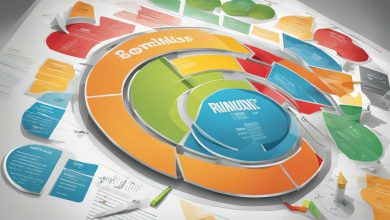
Effective risk management is an integral part of successful project management. It involves identifying potential risks, assessing their potential impact, and developing strategies to mitigate or manage them. Being able to predict and navigate challenges is crucial for achieving project objectives and ensuring project success. Therefore, mastering risk management strategies is essential for project managers.
Key Takeaways
- Effective risk management is critical for project success.
- Identifying and assessing project risks is important.
- Proactively developing strategies to mitigate or manage risks is essential.
- Ongoing monitoring and managing of risks throughout the project lifecycle is necessary.
Understanding Project Risks
Risk management is a critical component of project management. Identifying and assessing project risks is essential to ensure successful project outcomes. Conducting a thorough risk analysis helps project managers to anticipate potential problems, allocate resources, and make informed decisions.
Project risks can be broadly categorized into three types:
- Technical risks: related to hardware, software, or other technical components of the project
- External risks: factors beyond the control of the project team, such as changes in market conditions, legal and regulatory changes
- Organizational risks: related to internal factors, such as resource availability, stakeholder engagement, and project management practices
Project risk assessment involves identifying potential risks and estimating their likelihood and impact. The outcome of this assessment is a risk register that serves as a basis for developing risk management strategies.
Project risk analysis involves a more detailed examination of individual risks. The analysis enables the project team to prioritize risks and allocate resources to mitigate them. The analysis may also involve developing contingency plans for potential risks that cannot be avoided.
Strategies for Risk Identification
Effective risk management starts with identifying potential risks that could affect project objectives. The ability to predict and anticipate potential risks can play a huge role in project success. Here are some techniques and strategies for mastering risk identification:
- Involving Stakeholders: Engage project stakeholders, including clients, off-site teams, and suppliers, to gather diverse perspectives on potential risks. This not only ensures that all aspects of the project are being considered, but also encourages collaboration and communication.
- Brainstorming Sessions: Hold group discussions among key team members to generate ideas and identify the most relevant risks. Set clear objectives and brainstorm using specific scenarios to forecast project challenges and mitigate the risks they present.
- Checklist Approach: Use risk identification checklists that cover standard project risks, allowing you to quickly identify potential threats. These checklists can be customized to fit specific project needs, to ensure that no potential risk goes unnoticed.
- Swot Analysis: SWOT (Strengths, Weaknesses, Opportunities, and Threats) analysis is a technique that can be used to identify potential risks and opportunities. It helps to generate a list of threats that could compromise the project’s ability to deliver on its objectives.
- Lesson Learned: Reviewing the outcomes of past projects can help identify potential risks that may arise in current projects. Documenting lessons learned can be a valuable reference for risk identification and management.
By mastering the techniques and strategies mentioned above for risk identification, project managers can develop an effective risk management plan that takes all potential risks into account. This will ultimately lead to better project outcomes and a more successful project overall.
Evaluating Project Risks
Identifying project risks is only the first step in effective risk management. Once risks have been identified, they must be evaluated to determine their potential impact on the project. Risk evaluation involves assessing the likelihood of a risk occurring and the magnitude of its impact on the project if it does occur.
There are several methods for evaluating project risks, including probability/impact matrix, risk scoring, and risk mapping. A probability/impact matrix involves assessing the likelihood and impact of each risk and plotting the results on a matrix to prioritize risks. Risk scoring involves assigning a numerical score to each risk based on its magnitude and likelihood. Risk mapping involves visually representing risks and their interrelationships to better understand their impact on the project.
Regardless of the method used, it is important to prioritize risks based on their potential impact on project objectives. This information can be used to develop risk response plans that outline strategies for mitigating or avoiding each risk.
Mitigating Project Risks
When it comes to risk management, the focus is not just on identifying and evaluating project risks, but also on mitigating them. Effective risk management involves developing and implementing strategies to reduce the likelihood of risks occurring and minimize their impact on project objectives.
One common approach to mitigating project risks is proactive risk management. In this approach, project managers and stakeholders work together to identify potential risks and develop contingency plans to address them before they become issues. This can involve developing alternative plans, establishing backup resources, or implementing preventative measures to reduce the likelihood of risks occurring.
Another important aspect of mitigating project risks is developing risk strategies. These are plans that outline how to respond to identified risks should they occur. Effective risk strategies should be tailored to the specific risks being addressed and should include steps for mitigating the risks, such as transferring the risks to another party, accepting the risks, or avoiding the risks altogether.
Ultimately, effective risk mitigation requires a combination of proactive risk management and effective risk strategies. By identifying potential risks early on, working collaboratively with stakeholders, and developing targeted mitigation strategies, project managers can minimize the impact of risks on project outcomes and ensure project success.
Monitoring and Managing Risks
Effective risk management requires ongoing monitoring and proactive management throughout the project lifecycle. Regular risk assessments should be conducted to evaluate the effectiveness of risk management strategies and adjust them as needed.
Proactive risk management involves anticipating potential risks and taking steps to mitigate them before they become major issues. This approach can help project teams stay ahead of potential challenges.
One key aspect of monitoring and managing risks is effective communication. Project teams should ensure that all stakeholders are aware of potential risks and the steps being taken to mitigate them. This can help prevent misunderstandings and ensure that everyone is on the same page.
Technology can also play a role in effective risk management. Tools such as project management software and risk assessment software can help teams track project risks and monitor progress in mitigating them.
To be successful in monitoring and managing risks, project teams must remain proactive and engaged throughout the project lifecycle. By regularly assessing and adjusting risk management strategies and leveraging technology and effective communication, teams can effectively navigate potential challenges and ensure project success.
Overcoming Challenges in Risk Management
Managing risks in projects can be a challenging task, often requiring quick and effective decision-making. However, effective risk management is an essential component of project success. Here are some common challenges faced in risk management and strategies for navigating them:
Communication
Poor communication can lead to misunderstandings and misinterpretations, resulting in mismanagement of risks. Effective communication is key to successful risk management. It is important to establish clear lines of communication between team members, stakeholders, and project sponsors. Regular meetings and reporting can help ensure everyone is on the same page and any risks can be promptly identified and addressed.
Collaboration
Collaboration is crucial in risk management. However, it can be difficult to get everyone on board with risk management strategies. Effective collaboration requires mutual respect, trust, and shared goals. Project managers should encourage collaboration by involving team members in the risk management process and creating a culture that values risk management.
Technology
Technology can be a double-edged sword in risk management. While it can streamline risk management processes and improve communication, it can also introduce new risks. It is important to carefully evaluate and select risk management tools that align with the project’s objectives and risk management strategies. It is also important to ensure that all team members are trained in using these tools to maximize their effectiveness.
Conclusion
Effective risk management is critical to project success. By understanding the common challenges and implementing strategies to navigate them, project managers can improve their chances of successfully managing risks and achieving project objectives. By mastering risk management, predicting challenges in projects, and effectively navigating them, project managers can ensure successful project outcomes.
Conclusion
Mastering risk management is crucial for predicting and navigating challenges in projects. As discussed, understanding project risks, identifying them, evaluating them, mitigating them, and monitoring and managing them are essential steps in effective risk management. By applying these strategies and techniques, project managers can increase the likelihood of successful project outcomes.
It is important to remember that risk management is an ongoing process that requires regular assessment and adjustment. By prioritizing effective risk management, project managers can proactively address potential issues and ensure that projects stay on track.
By applying the strategies and techniques discussed in this article, readers can begin mastering risk management in their own project management endeavors. By effectively predicting and navigating challenges, project managers can increase the likelihood of successful project outcomes and ensure that projects are completed on time, on budget, and to the satisfaction of stakeholders.
FAQ
Q: What is risk management in project management?
A: Risk management in project management refers to the process of identifying, analyzing, and mitigating potential risks that may impact the success of a project. It involves predicting and navigating challenges to ensure project objectives are achieved.
Q: Why is risk management important in projects?
A: Risk management is important in projects because it helps to prevent or minimize potential problems that could negatively impact project outcomes. It allows project managers to anticipate and address challenges proactively, increasing the likelihood of project success.
Q: What are some common challenges in risk management?
A: Some common challenges in risk management include inadequate risk identification, limited stakeholder engagement, and resistance to change. Effective communication and collaboration, along with the use of technology, can help overcome these challenges.
Q: How can I effectively mitigate project risks?
A: To effectively mitigate project risks, it is important to adopt a proactive approach. This includes developing contingency plans, regularly monitoring and evaluating risks, and implementing appropriate risk mitigation strategies. Engaging stakeholders and utilizing their expertise can also contribute to successful risk management.
Q: Can risk management strategies be applied to any type of project?
A: Yes, risk management strategies can be applied to any type of project, regardless of its size or nature. Whether it is a construction project, software development, or event planning, identifying and addressing potential risks is essential for successful project execution.








